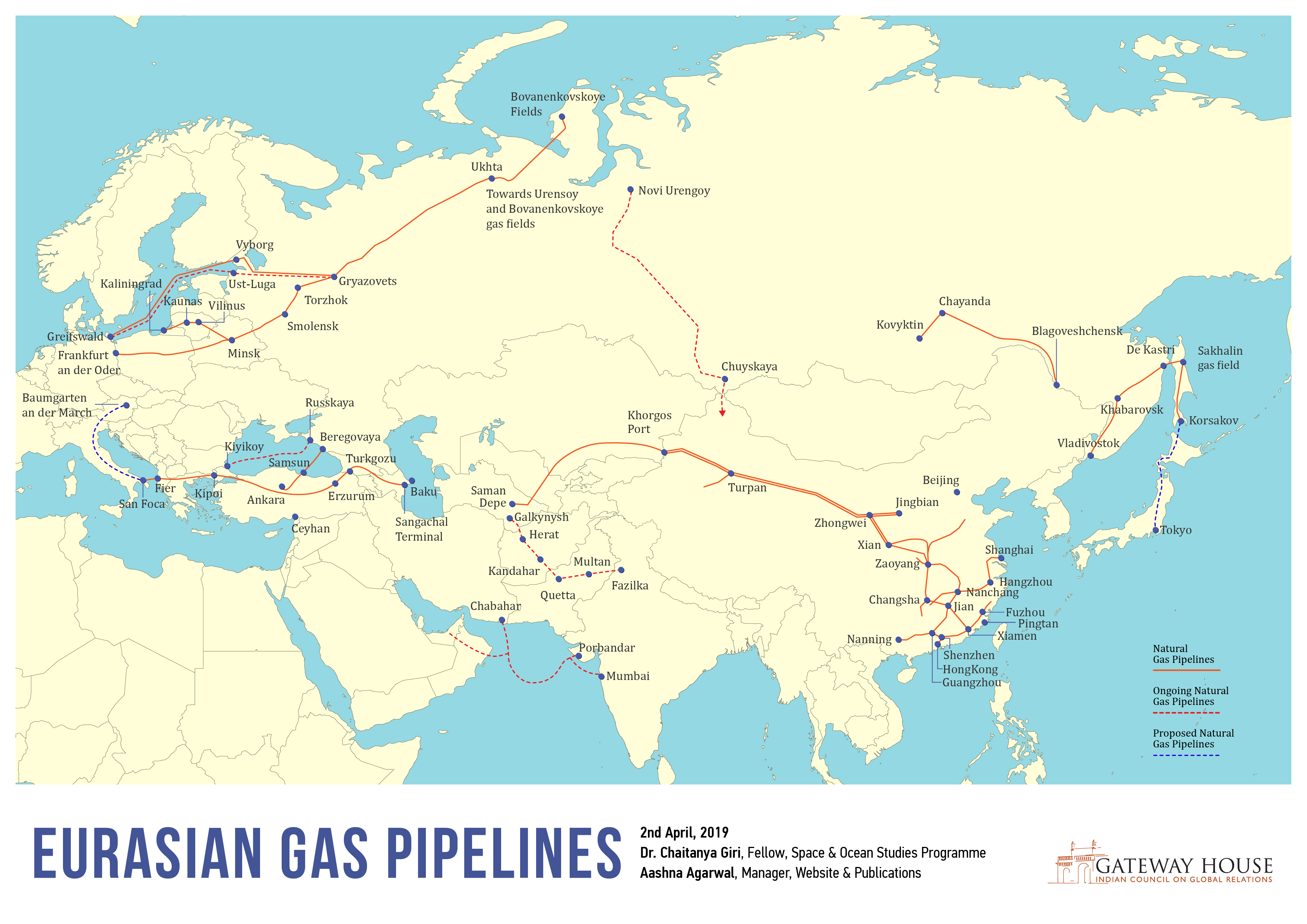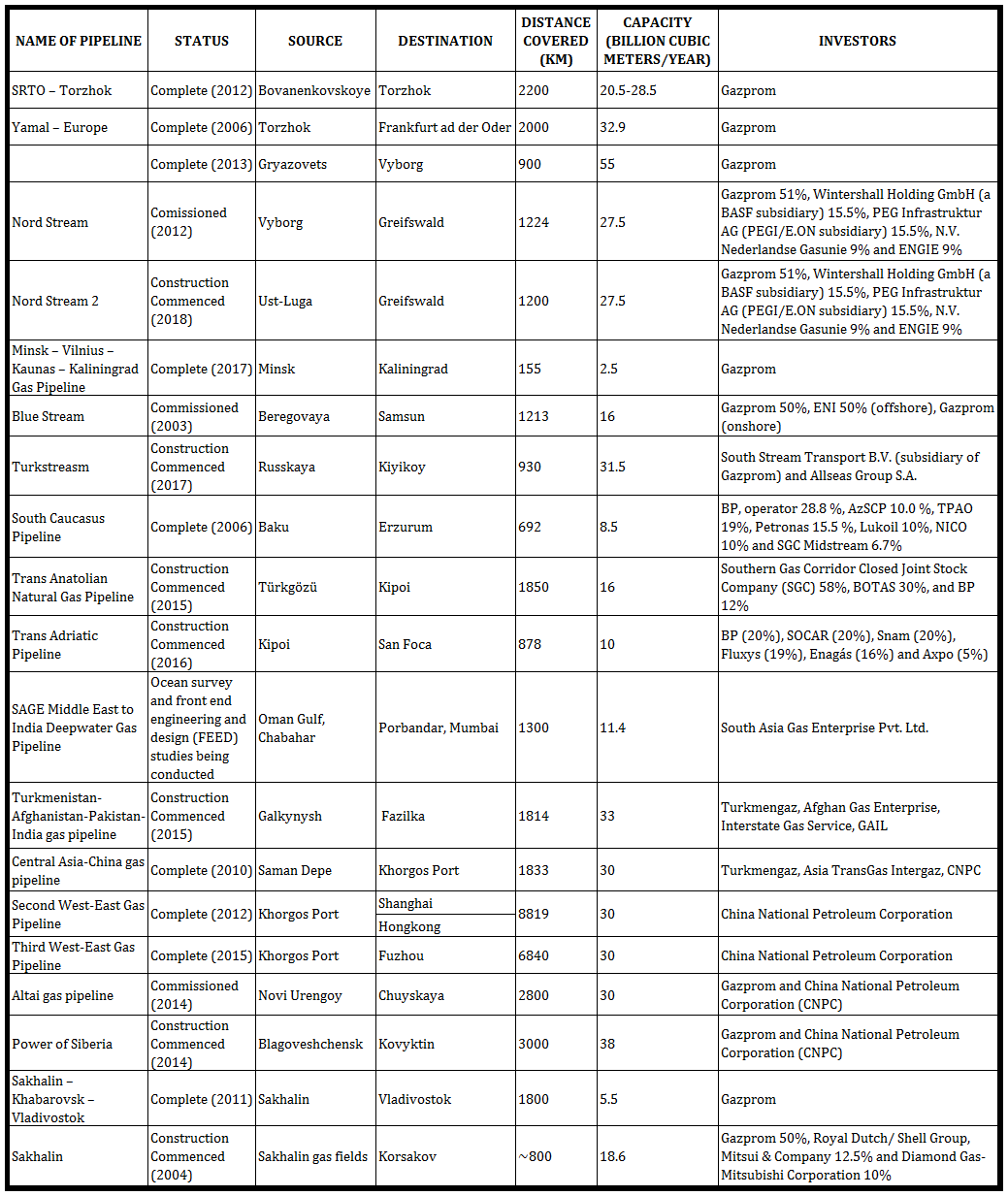The area encompassing the sovereign territories of the Shanghai Cooperation Organisation’s (SCO) member states[1] and the countries on their peripheries – Iran, Azerbaijan, Turkmenistan – holds some of the largest fossil fuel reserves in the world. It is home to 25% of the world’s oil and 50% of its total natural gas reserves, with the largest market for this in the neighbouring regions of Europe and South and East Asia. Moscow, a global energy superpower and co-founder of this grouping, put its heft to good use to form the SCO Energy Club in 2013, with the objective of acquiring a market for these commodities.
Natural gas is the cleanest and most sought-after fossil fuel for the future, and the SCO Energy Club, largely led by Moscow, is creating supply lines for its plentiful natural gas reserves. These pipelines pass through many countries, some of which are not SCO members while others have SCO observer or dialogue partner status. Their cooperation for the project was obtained when the SCO Energy Club met in 2017 under the club presidency of Turkey, an SCO dialogue partner. The 2017 meeting was significant, as other non-member countries such as Mongolia, Belarus, Iran, Afghanistan and Sri Lanka, were invited. Most of these non-member nations are crucial intermediaries in the transport of energy to large, fossil fuel-deficient markets, such as China, Japan, Europe, Korea and India. They are located along the pipeline routes, and Sri Lanka has a major China-built LNG terminal at Hambantota.
This map shows some of the important trans-national natural gas pipelines – constructed, under-construction, and proposed – originating from Russia, Azerbaijan and Turkmenistan; those that pass through the SCO member countries, and those non-members which have been participants in the SCO Energy Club meetings.

Geopolitical complexities deprive India of secure, long-term supplies of land-based and under-water pipeline natural gas from Central Asia, Iran and Qatar. Instead, it must look to secure ship-based LNG supplies from natural gas reserves from the SCO countries, currently inaccessible to it.
Gateway House has the following tactical recommendations for the next Indian government (2019-2024) when it takes office:
1. The Prime Minister of India has been invited to the Eastern Economic Forum in Vladivostok, Russia in September 2019 by Russian president Vladimir Putin. This is the opportunity to secure low-cost, long-term, LNG supplies from the Sakhalin reserves in the Russian Far East. These can potentially be cheaper than that which India currently sources from the more distant the Yamal Peninsula on Russia’s Arctic coast.
2. India intends to increase natural gas in its energy mix from the current 6% to 15% by 2030. As a major market for LNG from Russia, India should seek the Presidency of the SCO Energy Club annual meeting in 2020-2021 – a year before India’s G20 Presidency in 2022. India has been an SCO member since 2017, but has not yet entrenched itself into specific SCO sub-groupings, including the Energy Club.
If India succeeds in gaining the SCO Energy Club presidency, it can:
- Secure its energy needs for the decade of the 2020s, when GDP growth will be high;
- Prepare to make strategic upstream and downstream investments in the energy sector within the SCO’s jurisdiction.

Chaitanya Giri is Fellow, Space and Ocean Studies, Gateway House.
Aashna Agarwal is Manager, Website and Publications, Gateway House.
Designed by Debarpan Das
This infographic was exclusively created for Gateway House: Indian Council on Global Relations. You can read more exclusive content here.
For interview requests with the author, or for permission to republish, please contact outreach@gatewayhouse.in.
© Copyright 2019 Gateway House: Indian Council on Global Relations. All rights reserved. Any unauthorized copying or reproduction is strictly prohibited.
References
[1] India, Kazakhstan, China, Kyrgyz, Pakistan, Russia, Tajikistan, Uzbekistan
[2] China National Petroleum Corporation, ‘West-East Gas Pipeline Project (2002-2013) Special Report On Social Responsibility’, Overview Of The West-East Gas Pipeline Project. <http://www.cnpc.com.cn/en/cs2012en/201407/3d2ccb479ad94ef4a6c54ce4d78685fa/files/8440f95e4b454eb082d557b5261d667c.pdf>
[3] Exxon Neftegas Limited, ‘About The Sakhalin-1 Project’, Exxon Mobil,< https://www.sakhalin-1.com/en-ru/company/about-us/about-sakhalin-1-project/histor>
[4] Gazprom, ‘Blue Stream’,Gazprom com,< http://www.gazprom.com/projects/blue-stream/>
[5] Gazprom, ‘Bovanenkovskoye Field’, Gazprom com, <http://www.gazprom.com/projects/bovanenkovskoye/>
[6] Gazprom, ‘Gryazovets – Vyborg’, Gazprom com, < http://www.gazprom.com/projects/gryazovets-vyborg/>
[7] Gazprom, ‘Minsk – Vilnius – Kaunas – Kaliningrad’, Gazprom com, <http://www.gazprom.com/projects/mvkk/>
[8] Gazprom, ‘Nord Stream 2’, Gazprom com, < http://www.gazprom.com/projects/nord-stream2/>
[9] Gazpro, ‘Nord Stream: The Gas Pipeline Directly Connecting Russia And Europe’, Gazprom com, < http://www.gazprom.com/projects/nord-stream/>
[10] Gazprom, ‘Power Of Siberia’. Gazprom com, < http://www.gazprom.com/projects/power-of-siberia/>
[11] Gazprom, ‘Sakhalin III’, Gazprom com, < http://www.gazprom.com/projects/sakhalin3/>
[12] Gazprom, ‘Sakhalin – Khabarovsk – Vladivostok’, Gazprom com, <http://www.gazprom.com/projects/skhv/>
[13] Gazprom, ‘SRTO – Torzhok’, Gazprom com ,< http://www.gazprom.com/projects/srto-torzhok/>
[14] Gazprom, ‘Turkstream’, Gazprom com, < http://www.gazprom.com/projects/turk-stream/>
[15] Gazprom, ‘Yamal – Europe’, Gazprom com ,<http://www.gazprom.com/projects/yamal-europe/>.
[16] Heinrich, Andreas, and Heiko Pleines, eds., Export Pipelines From The CIS Region: Geopolitics, Securitization, And Political Decision Making. ( Stuttgart: Ibidem-Verlag, 2014).
[17] Hydrocarbons Technology, ‘Central Asia-China Gas Pipeline, Turkmenistan To China – Hydrocarbons Technology’, Hydrocarbons Technology, < https://www.hydrocarbons-technology.com/projects/centralasiachinagasp/>
[18] Nord Stream, ‘Who We Are’, Nordstream, < https://www.nord-stream.com/about-us/>
[19] SAGE India, SAGE Pipeline – Pipeline Construction Projects, Project Overview’, SAGE< http://www.sage-india.com/index.php?option=com_content&view=article&id=57&Itemid=63>
[20] Sakhalin Energy, 2004 Annual Review, < http://www.sakhalinenergy.ru/upload/iblock/31a/Sakhalin_English_04.pdf>
[21] Socar Midstream, ‘South Caucasus Pipeline (SCP)’, Socar Midstream < http://www.socarmidstream.az/project/scp/#overview>
[22] TANAP, ‘Major Shareholder In The Project Of The Century!’. TANAP, <https://www.tanap.com/media/press-releases/major-shareholder-in-the-project-of-the essed AprAccil -century/>
[23] TANAP, ‘Why TANAP’, TANAP, < https://www.tanap.com/tanap-project/why-tanap/>
[24] TAP, ‘Southern Gas Corridor’, TAP , <https://www.tap-ag.com/the-pipeline/the-big-picture/southern-gas-corridor>.
[25] TAP, ‘TANAP And TAP Complete Pipeline Connection’, TAP, < https://www.tap-ag.com/news-and-events/2018/11/27/tanap-and-tap-complete-pipeline-connection>.
[26] TAP, ‘TAP At A Glance’, TAP, <https://www.tap-ag.com/the-pipeline>
[27] TASS, ‘Altai Gas Pipeline’, TASS, < http://tass.com/infographics/7251>
[28] Trans Austria Gasleitung, Competence Center of TAG GMBH At A Glance. <http://52.212.102.196/fileadmin/content/TAG-Website-Content-PA/20180827_TAG_Pipelinekarte_EN.pdf>
[29] ‘Project’, Turkstream, < http://turkstream.info/project/>
[10] 2b1st Consulting, ‘SAGE To Build Middle-East To India Deepwater Gas Pipeline’, SAGE, <https://www.2b1stconsulting.com/sage-to-build-middle-east-to-india-deepwater-gas-pipeline/>